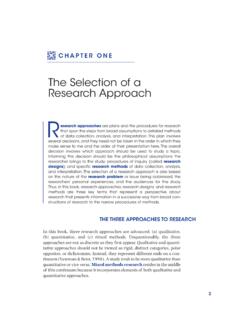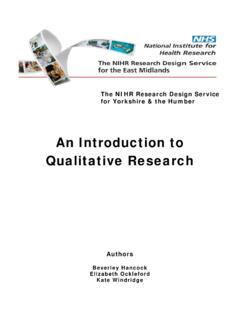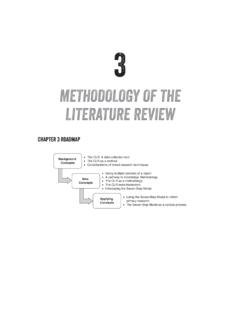Transcription of The Selection of a Research Design
1 CHAPTER ONEThe Selection ofa Research DesignResearch designsare plans and the procedures for Research thatspan the decisions from broad assumptions to detailed methodsof data collection and analysis. This plan involves several deci-sions, and they need not be taken in the order in which they make senseto me and the order of their presentation here. The overall decisioninvolves which Design should be used to study a topic. Informing thisdecision should be the worldview assumptions the researcher brings tothe study; procedures of inquiry (called strategies); and specific meth-ods of data collection, analysis, and interpretation. The Selection of aresearch Design is also based on the nature of the Research problem orissue being addressed, the researchers personal experiences, and theaudiences for the THREE TYPES OF DESIGNSIn this book, three types of designs are advanced: qualitative, quantitative ,and mixed methods.
2 Unquestionably, the three approaches are not as dis-crete as they first appear. Qualitative and quantitative approaches shouldnot be viewed as polar opposites or dichotomies; instead, they representdifferent ends on a continuum (Newman & Benz, 1998). A study tends to bemore qualitative than quantitative or vice versa. Mixed methods researchresides in the middle of this continuum because it incorporates elementsof both qualitative and quantitative the distinction between qualitative and quantitative researchis framed in terms of using words (qualitative) rather than numbers( quantitative ), or using closed-ended questions ( quantitative hypotheses)rather than open-ended questions (qualitative interview questions). Amore complete way to view the gradations of differences between them isin the basic philosophical assumptions researchers bring to the study, the301-Creswell (RD)-45593:01-Creswell (RD) 6/20/2008 4:36 PM Page 34types of Research strategies used overall in the Research ( , quantitativeexperiments or qualitative case studies), and the specific methodsemployed in conducting these strategies ( , collecting data quantita-tively on instruments versus collecting qualitative data through observinga setting).
3 Moreover, there is a historical evolution to both approaches,with the quantitative approaches dominating the forms of Research in thesocial sciences from the late 19th century up until the mid-20th the latter half of the 20th century, interest in qualitative researchincreased and along with it, the development of mixed methods Research (see Creswell, 2008, for more of this history). With this background, itshould prove helpful to view definitions of these three key terms as used inthis book: Qualitative researchis a means for exploring and understandingthe meaning individuals or groups ascribe to a social or human process of Research involves emerging questions and procedures, datatypically collected in the participant s setting, data analysis inductivelybuilding from particulars to general themes, and the researcher makinginterpretations of the meaning of the data. The final written report has aflexible structure.
4 Those who engage in this form of inquiry support a wayof looking at Research that honors an inductive style, a focus on individualmeaning, and the importance of rendering the complexity of a situation(adapted from Creswell, 2007). quantitative researchis a means for testing objective theories byexamining the relationship among variables. These variables, in turn, canbe measured, typically on instruments, so that numbered data can be ana-lyzed using statistical procedures. The final written report has a set struc-ture consisting of introduction, literature and theory, methods, results,and discussion (Creswell, 2008). Like qualitative researchers, those whoengage in this form of inquiry have assumptions about testing theoriesdeductively, building in protections against bias, controlling for alternativeexplanations, and being able to generalize and replicate the findings. Mixed methods researchis an approach to inquiry that combinesor associates both qualitative and quantitative forms.
5 It involves philo-sophical assumptions, the use of qualitative and quantitative approaches,and the mixing of both approaches in a study. Thus, it is more than sim-ply collecting and analyzing both kinds of data; it also involves the use ofboth approaches in tandem so that the overall strength of a study isgreater than either qualitative or quantitative Research (Creswell & PlanoClark, 2007).These definitions have considerable information in each one of this book, I discuss the parts of the definitions so that theirmeanings become clear to Considerations01-Creswell (RD)-45593:01-Creswell (RD) 6/20/2008 4:36 PM Page 4 The Selection of a Research DesignTHREE COMPONENTS INVOLVED IN A DESIGNTwo important components in each definition are that the approach toresearch involves philosophical assumptions as well as distinct methodsor procedures. Research Design , which I refer to as the plan or proposalto conduct Research , involves the intersection of philosophy, strategies ofinquiry, and specific methods.
6 A framework that I use to explain the inter-action of these three components is seen in Figure To reiterate, inplanning a study, researchers need to think through the philosophicalworldview assumptions that they bring to the study, the strategy of inquirythat is related to this worldview, and the specific methods or procedures ofresearch that translate the approach into WorldviewsAlthough philosophical ideas remain largely hidden in Research (Slife &Williams, 1995), they still influence the practice of Research and need tobe identified. I suggest that individuals preparing a Research proposal or planmake explicit the larger philosophical ideas they espouse. This informationwill help explain why they chose qualitative, quantitative , or mixed methods5 Research MethodsQuestionsData collectionData analysisInterpretationWrite-upValidation Research DesignsQualitativeQuantitativeMixed methodsSelected Strategiesof InquiryQualitative strategies( , ethnography) quantitative strategies( , experiments)Mixed methods startegies( , sequential)PhilosophicalWorldviewsPostpo sitiveSocial constructionAdvocacy/participatoryPragma ticFigure Framework for Design The Interconnection of Worldviews, Strategiesof Inquiry, and Research Methods01-Creswell (RD)-45593:01-Creswell (RD) 6/20/2008 4.
7 36 PM Page 5 PostpositivismConstructivism Determination Understanding Reductionism Multiple participant meanings Empirical observation Social and historical constructionand measurement Theory generation Theory verificationAdvocacy/ParticipatoryPragma tism Political Consequences of actions Empowerment Issue-oriented Problem-centered Collaborative Pluralistic Change-oriented Real-world practice oriented6approaches for their Research . In writing about worldviews, a proposalmight include a section that addresses the following: The philosophical worldview proposed in the study A definition of basic considerations of that worldview How the worldview shaped their approach to researchI have chosen to use the term worldviewas meaning a basic set ofbeliefs that guide action (Guba, 1990, p. 17). Others have called themparadigms (Lincoln & Guba, 2000; Mertens, 1998); epistemologiesand ontolo-gies(Crotty, 1998), or broadly conceived Research methodologies(Neuman,2000).
8 I see worldviews as a general orientation about the world and thenature of Research that a researcher holds. These worldviews are shaped bythe discipline area of the student, the beliefs of advisers and faculty in a stu-dent s area, and past Research experiences. The types of beliefs held by indi-vidual researchers will often lead to embracing a qualitative, quantitative ,or mixed methods approach in their Research . Four different worldviews arediscussed: postpositivism, constructivism, advocacy/participatory, and prag-matism. The major elements of each position are presented in Table Postpositivist WorldviewThe postpositivist assumptions have represented the traditional form ofresearch, and these assumptions hold true more for quantitative researchthan qualitative Research . This worldview is sometimes called the scientificmethodor doing science Research . It is also called positivist/postpositivistresearch, empirical science, and postpostivism.
9 This last term is called post-positivism because it represents the thinking after positivism, challengingPreliminary ConsiderationsTable Worldviews01-Creswell (RD)-45593:01-Creswell (RD) 6/20/2008 4:36 PM Page 6 The Selection of a Research Designthe traditional notion of the absolute truth of knowledge (Phillips &Burbules, 2000) and recognizing that we cannot be positive about ourclaims of knowledge when studying the behavior and actions of postpositivist tradition comes from 19th-century writers, such asComte, Mill, Durkheim, Newton, and Locke (Smith, 1983), and it has beenmost recently articulated by writers such as Phillips and Burbules (2000).Postpositivists hold a deterministic philosophy in which causes prob-ably determine effects or outcomes. Thus, the problems studied by post-positivists reflect the need to identify and assess the causes that influenceoutcomes, such as found in experiments.
10 It is also reductionistic in that theintent is to reduce the ideas into a small, discrete set of ideas to test, suchas the variables that comprise hypotheses and Research questions. Theknowledge that develops through a postpositivist lens is based on carefulobservation and measurement of the objective reality that exists outthere in the world. Thus, developing numeric measures of observationsand studying the behavior of individuals becomes paramount for a post-positivist. Finally, there are laws or theories that govern the world, andthese need to be tested or verified and refined so that we can understandthe world. Thus, in the scientific method, the accepted approach toresearch by postpostivists, an individual begins with a theory, collects datathat either supports or refutes the theory, and then makes necessary revi-sions before additional tests are reading Phillips and Burbules (2000), you can gain a sense of the keyassumptions of this position, such as, is conjectural (and antifoundational) absolute truthcan never be found.
















